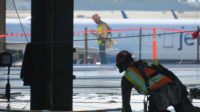Transportation
AECOM Wins PM Contract for $8.2B Portal Project in San Francisco

Planned new hub will connect 11 transit lines in heart of San Francisco.
Rendering courtesy of TJPA
The planned $8.25-billion project to connect 11 rail lines in the heart of San Francisco took a step forward this summer with AECOM chosen as the program manager. The Transbay Joint Powers Authority (TJPA) is seeking ways to fill a $2.75-billion funding gap, including pursuit of a Full Funding Grant Agreement (FFGA) from the Federal Transit Administration (FTA) and a potential regional transportation ballot measure in 2026.
AECOM announced on Aug. 21 its award (in June) of program management and construction management services for the 2.2-mile, 2-station Downtown Rail Extension (DTX) project, also known as the Portal. The megaproject, with 1.5 miles of tunnel, will extend Caltrain service from its current terminal at Fourth and King Streets to the Salesforce Transit Center, and accommodate future California High-Speed Rail service. Once complete, it will serve as a key regional rail connection with a combined average ridership forecast of 90,000 daily riders.
AECOM leads Portal Connectors, the team tasked with helping the TJPA obtain federal funding, finalizing the procurement plan in 2024, activating collaborative delivery models, designing and building the stations, and integrating The Portal with existing rail systems and operations. The team will transition to construction management when work on the project begins.
The 1.3-mile rail extension is expected to be constructed principally below grade using cut-and-cover and mined tunneling methods, according to AECOM and TJPA. The project includes an underground station at Fourth and Townsend Streets along with the Salesforce Transit Center’s basement levels, utility relocation, track and systems work. The original planned completion is 2032.
According to TJPA’s board meeting minutes in June, the contract has a five-year term in an amount not to exceed $158,165,635, with two options to extend for two years each in an aggregate amount not to exceed $297,335,420.
“Our capabilities across all forms of rail projects, from urban transit to high-speed and regional rail, continue to make us a trusted partner for our global clients seeking integrated rail solutions,” said Drew Jeter, chief executive of AECOM’s Program Management global business line, in the press release. “We look forward to leveraging these capabilities as we help deliver this multi-modal transit hub, which will support transformative mobility and environmental benefits for the Bay Area and beyond.”
TJPA also shortlisted three teams that responded to its RFQ for a progressive design-build civil and tunnel construction of the project issued last year. They are Barnard Construction with lead designer Hatch Associates Consultants; Flatiron-Dragados-Obayashi with AZTEC-TYPSA and Arcadis as the lead designers; and a team of Kiewit as lead contractor and designer.
According to the TJPA website, the winning team is to be selected in October. However, in a July board meeting report, the authority noted that “In order to submit a request to begin negotiation of an FFGA, FTA requires, among other things, that a potential Grantee demonstrate that all non-CIG [Capital Investment Grants] funds be committed to the project. Under the current approved Accelerated Master Schedule, TJPA would have to demonstrate that commitment in October of 2024. There is no credible path to identifying the required $2.751 billion in that timeframe. Additional time will be required for TJPA, working with local, regional, state, and federal partners to identify such funding.”
The TJPA did not immediately reply to a request for comment.
Looking Ahead
According to the July 17 board report, the FTA has committed $3.384 billion in CIG funding, and TJPA has identified $1.390 billion from various local, regional, and state sources, leaving a funding gap of $2.751 billion under the current schedule.
The TBJA is working on value engineering and scope modifications to the program, and is considering multiple scenarios regarding whether an FFGA can be obtained in an extra year to two years. “Schedule change scenarios would result in additional escalation of approximately $300-$600 million,” the report states.
Project officials have identified $541 million in potential value engineering savings so far, according to the report. They are seeking another $1 billion in state funding, and propose to form a working group with city and county officials to identify potential local funding sources.
"We are approaching a number of sources," said Adam van de Water, executive director of the TJPA, addressing the board at its June 13 meeting. He said the agency has applied for grants under the Federal Railroad Administration's Consolidated Rail infrastructure and Safety Improvements program and the U.S. Dept. of Transportation's Mega Grant program.
"These are very competitive grant opportunities," he said. "They are critical for us because they will fund the advancement of our design...and the forthcoming RFP for the progressive design-build contract."
He noted that the new executive working group identified three scope reductions so far: elimination of the train box extension at Beale Street to accommodate future high-speed rail 16-car double train sets; shortening a planned bus facility extension and deferring a warranty period for operations and maintenance for the high-speed rail.
The 2.2-mile, 2-station project includes 1.5 miles of tunnel beneath San Francisco's downtown.
Rendering courtesyTJAP
A proposed SB 1031 regional transportation measure "has a number of policy considerations baked in" and negotiations among stakeholders will continue into 2025, he added. But that "will not necessarily impact timing" for putting the measure on the 2026 ballot, he said.
Recommendations include continuing with certain procurement activities, including “start the approximately 18-month process of bringing the [progressive design-build] contractor up to speed,” advance preconstruction work, and complete procurement documents for all packages, according to the July report.
The construction of the Salesforce Tower included an underground box in preparation for the planned Portal project, funded by $400 million in federal American Recovery and Reinvestment Act funds.



